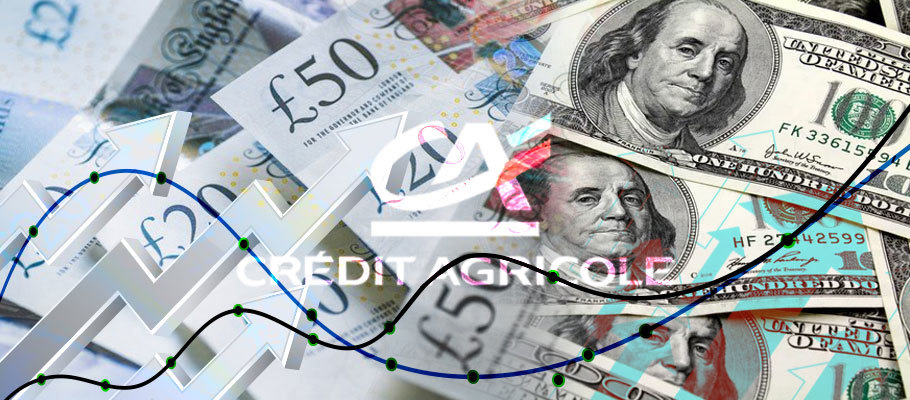
Published: April 26th, 2023
Analysts at Paris-based global investment bank Credit Agricole (CA) say USD is unlikely to slide into a more protracted downtrend, despite recent weakness. If that’s the case, it will stop the Pound to Dollar exchange rate (GBP/USD) from reaching new highs.
CA analysts see three factors supporting USD’s current price range.
Number one is a Federal Reserve policy pivot that could put the US central bank on a less dovish footing. Next week the US central bank is expected to raise rates for the last time in the current cycle, however Credit Agricole believes the Fed’s monetary policy committee will also push back against market pricing of rate cuts.
Consensus is growing that the Fed will hike interest rates by an additional 25 basis points, but the committee could signal this is the end of the cycle.
Despite that, the Fed would still be keen to demonstrate to markets that any notion of rate cuts would be premature. This, CA analysts say, could provide some support for the Dollar.
The latest money market pricing suggests investors are expecting rate cuts to return in the second half of 2023, with the Fed prompted to action by a steep slowdown in the economy.
At the moment, markets think the Fed will cut rates more aggressively than any other G10 central bank as the year progresses, an expectation that has led to a decline in the Greenback and pushed GBP/USD to a record a three per cent advance for the year to date.
Credit Agricole believes looming US economic stats will confirm that high inflation isn’t going away, suggesting the Fed will need to keep ‘rates aloft for a longer stretch and put pressure on investor risk sentiment, factors that should give a boost to the safe-haven Dollar.’
The third possible source of USD support will be the unending debate around the American government’s legal debt ceiling, which politicians will need to lift again.
The US Treasury hit its upper debt limit in mid-January 2023, meaning it now relies solely on incoming tax revenue and a few ‘extraordinary measures’ to fund government operations. Analysts including Credit Agricole believe the cash taps will run out as soon as late June or early July 2023 unless the US Congress takes action.
‘If action isn't taken soon to raise the debt limit it will have catastrophic consequences for America’s economy,’ the US Treasury Department wrote a recent press statement. ‘The federal government would be required to default on its domestic and international debt obligations. This would be unprecedented in American history and upset markets around the globe.’
Using increasingly stark language, the Treasury also wrote that there ‘is a risk that such an event could trigger another financial crisis, threatening the savings and livelihoods of normal Americans while pulling the United States back into economic difficulty just as it finally recovers from the last recession’.
In January, Sterling strength was the decisive factor in the pair’s pricing. A first economic print of the new year showed that Britain’s economy generated more jobs than anticipated in November 2022, alongside faster-than-anticipated wage growth. That combination of surprise labour market growth suggested the Bank of England (BoE) would need to respond by raising interest rates.
Sterling rose after the UK Office of National Statistics (ONS) reported an additional 27K jobs in the three months to November 2022. That projection was unchanged from the previous month, but consensus believed a slowdown to 5K new jobs was in the works.
Unemployment was unaffected, holding firm at 3.6 per cent. People signing on for unemployment benefits rose by 19.6K, less than the 19.7K markets were expecting.
Average earnings including bonuses grew by 6.3 per cent, a rise from October's 6.1 per cent and beating expectations that a 6.2 per cent print would emerge. Take bonuses away and the rate of wage growth rises slightly to 6.4 per cent.
'GBP is trending slightly higher this morning following a mixed UK jobs print,’ said Barclay’s Forex Strategy Unit in a note to investors. ‘Even as vacancies fall, a shortage of qualified workers is forcing firms to raise pay. Wages are going up at the fastest pace since records began, turning the spotlight on the Bank of England, which may need to hike interest rates again.’
That sense of something new happening was echoed by the ONS, which wrote that current wage growth represented 'the largest rate we’ve seen for the private sector.’
For Threadneedle Street to re-think its policy of raising interest rates, employment and wage growth must come down. This would be seen as proof that the economy was cooling, easing domestic inflation pressures.
Barcley’s said the situation pointed to another 50 basis-point hike in February 2023, followed by further increases.
GBP/USD started 2023 with price action that the paid might benefit from a resilient bid for Sterling near the 1.20 handle.
Markets were bearish on the Pound outlook in early January alongside positive prospects for the UK economy, but only if subsequent US economic prints give investors inspiration for fresh bids for Greenback exchange rates.
‘A Dollar index move through 103.50 could be sufficient to move GBP/USD back through 1.2100, but it’s our view that the pair will finish the week below 1.2000,’ said Barclays in an analyst note.
GBP/USD slid more than ten percent in the latter months of 2022 as gloomy forecasts for Britain’s economy and a reduced pace of Bank of England (BoE) interest rate rises relative to US Federal Reserve kept markets in bearish mode.
‘Westminster’s plans to reduce financial sector regulation post-Brexit could give net capital inflows a boost, though there are a number of potential risks which could weigh on Sterling's ascent in the first half of next year,’ added Barclays.